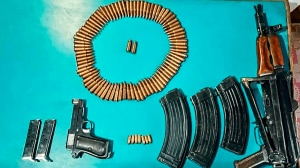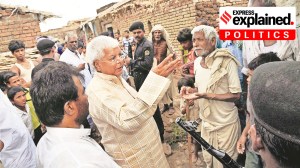Arabs rejoice as Westerners sneer at Saddam Hussein’s "heritage"
WASHINGTON, February 21: Bill Clinton says one Iraqi Presidential palace site is larger than Washington DC. Tony Blair says another is as la...

WASHINGTON, February 21: Bill Clinton says one Iraqi Presidential palace site is larger than Washington DC. Tony Blair says another is as large as Paris. The Arabs joke that it does not speak much of western cities. So what’s the truth about Saddam Hussein’s famed Presidential palaces, access or lack of it to which is all set to ignite a terrible mayhem on Iraq and decimate these very structures?
Few people have seen Saddam’s controversial palaces, but western reports speak of untold opulence, excessive narcissism, and riches beyond the dreams of avarice. In the ancient city of Babylon, for example, Saddam Hussein is said to have built a palace alongside the remains of the palace of Nebuchadnezzar II (630 – 562 B.C.). Each and every brick is stamped with "The Leader, Saddam Hussein, Victor of God," in order to link his reign with that of the ancient king.
Few people, much less westerners, have seen the interiors of the palaces, except for a rare treat some western TV crews got from Deputy Prime MinisterTariq Aziz who took them on a three-hour guided tour of Baghdad palaces in December.
Reports from that exclusive tour speak of lavish marble structures with domed roofs, arched doors and crystal chandeliers. Chairs are said to be upholstered in velvet, canopy beds draped with brocaded curtains, and in the bathrooms, pink bidets have gold-plated faucets. "They’re kitsch. Very expensive and distasteful," one western diplomat who saw the footage was quoted as saying.
But the current dispute does not center around Saddam’s bad taste or profligacy. The US and its allies are demanding free and unfettered access to eight Presidential sites, including the sprawling Republican Palace compound in Baghdad with its 700 buildings, which they suspect could hold remnants of an Iraqi biological and chemical weapons plan, if not canisters of poison itself.
"We are not interested in the palaces themselves so much as the store rooms that could be miles away (from living quarters) within the compound. And it is notnecessarily weapons, but sometimes documents we are looking for," says one UNSCOM inspector. Although UNSCOM was formed in the aftermath of Iraq’s defeat in the Gulf War to oversee destruction if Iraq’s weapons of mass destruction program, it was not until last year that it zeroed in on Saddam Hussein’s vast network of palaces, running into nearly 100 according to some estimates. According to US ambassador to UN Bill Richardson many of these buildings belong to and are part of a Presidential security network, which is also responsible for concealing weapons and documents from UN inspectors.
The Iraqis scoff at the idea that they may be hiding weapons in the palaces when they can easily do so in a huge countryside.
They also challenge western charges that they have not honoured their commitments to allow UN inspections. According to the Iraqi version, the eight Presidential sites they are holding out on constitute less than 1 per cent of UNSCOM’s total inspection activities all over Iraq. Even theseBaghdad is willing to open under a Russian initiative which will give primacy to a team of diplomats over the American-dominated UNSCOM team.
The Iraqis chafe at the roughshod methods of the western inspectors and argue that there must be a way to reconcile the legal requirements of the relevant Security Council resolutions and the legitimate concerns of Iraq over its integrity and sovereignty.
Says Nizar Hamdoon, Iraq’s ambassador to the UN: "Inspecting a great country like Iraq should and must not be like inspecting a deserted junkyard." The Iraqis are also angry at what they claim is distortion in the western media about the palaces. One Iraqi official claimed that most reports about the opulence was exaggerated and argued that archaeological restorations of some of the earliest known palaces to mankind undertaken by the Iraqi government was being counted as Saddam’s palaces. Besides, Iraq was also restoring the glory and heritage of its civilisation. But western observers sneer at the "heritage"argument saying much of the palace building is clearly aimed at Saddam’s personal aggrandisement. In another rare instance last month, some Baghdad diplomats were taken on a three-day palace tour by foreign minister Mohammed al-Sayaf. In Saddam’s home town of Tikrit, the palace in the final stages of completion had twelve villas and an artificial lake. "It is Saddam’s answer to Versailles," one diplomat said. Other western analysts point out that ordinary Iraqis have no access or idea about the scale and aggrandizement of their self-absorbed leader. The palaces, many of which have been built after the Gulf War debacle, are not open to the Iraqi public for fear of provoking a backlash in a country where hospitals have no medicines because of the economic sanctions.



- 01
- 02
- 03
- 04
- 05




























